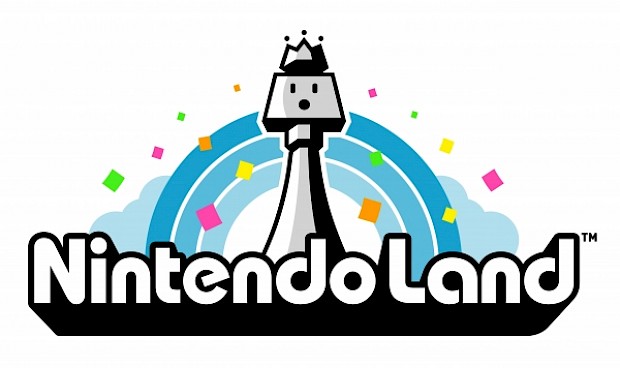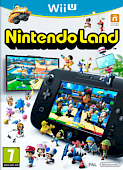Review: Nintendo Land

Posted 30 Nov 2012 at 13:03 by Ashley Jones
Roll up, roll up! Nintendo takes on the theme park in Nintendo Land, their GamePad companion designed to familiarise gamers with the new controller, in the same way that Wii Sports introduced the Wii Remote to millions around the world.
Much like Wii Sports, Nintendo Land contains a series of minigames that are designed to show off just what the GamePad can do and how you should interact with it. While Wii Sports lacked much depth, but players found themselves coming back often, Nintendo Land offers a lot more content.
Nintendo Land's twelve minigames fall into one of three categories: team play, competitive or single-player. The latter category has the most titles on hand, with six offerings, while the other two offer three games each. As is often the case with minigame collections, some are really enjoyable and addictive while others will played a few times and then forgotten.
When you first start Nintendo Land you are thrown into the theme park and meet Monita, a robot guide that will explain all your need to know. Like in many other similar games, a talkative guide can soon become tedious to listen to. Once you start playing the games she only talks to tell you how to play them, but even so it would be nice to have the details on screen as in the old Mario Party titles.
Unfortunately, while Nintendo Land is designed to simulate a Nintendo theme park it lacks any kind of life of excitement in the main overworld. The area is just a giant circle, with games dotted around the perimeter. While Miis collected from the Miiverse are drifting about, it feels like it is a glossy veneer put in place for the sake of style, reinforced when you are eventually allowed to choose games from a menu rather than having to walk to their entrance.
Exploring the main overworld is done so with the analogue sticks on the GamePad, while the camera is controlled using the inbuilt gyroscope, leading to some very dizzying experiences at first whilst you familiarise yourself with this setup.
 The visuals on offer are cute and cartoon-like, inkeeping with the design of Miis, but feature rich textures and detailed backgrounds designed to showcase the Wii U's graphical superiority over the Wii. Each level sees you dress up in different costumes, and some of the attention to detail, particularly to the costume textures, are quite impressive.
The visuals on offer are cute and cartoon-like, inkeeping with the design of Miis, but feature rich textures and detailed backgrounds designed to showcase the Wii U's graphical superiority over the Wii. Each level sees you dress up in different costumes, and some of the attention to detail, particularly to the costume textures, are quite impressive.
In the minigames the player’s face can be projected onto the TV screen thanks to the GamePad’s built in camera. This can be switched off, but it is quite fun seeing the reactions of the player, particularly if they’re not aware that you’re watching.
Playing the minigames earns you coins, which can be used in a panchiko machine. This then unlocks extras, which is a fun addition but probably something you’ll forget about after a while.
There is not much else to say about the overall package, so we shall now move onto a mini review of each of the twelve minigames:
The Legend of Zelda: Battle Quest (Team, 2-5 players)
One person controls an archer using the GamePad, while the rest control swordsmen. You must fight your way across numerous levels using your respective weapons. The levels start off easy, allowing you to slash your way through without much thought, but soon become more difficult.
The latter levels require you to really work together, relying on the slower-moving archer to take out potential threats as soon as possible. The Legend of Zelda: Battle Quest iis an enjoyable minigame with a surprising number of levels. Fans of the series will look forward to playing this one.
Pikmin Adventure (Team, 2-5 players)
In this game the GamePad player controls Captain Olimar, able to command his Pikmin to attack the robotic bugs that try and destroy you. The other player(s) control an individual Pikmin, able to headbutt its way to victory.
Along the way you can pick up nectar to grow your flower, or the flowers of Olimar's Pikmin, and increase your strength. This is a nice little game with numerous levels and while it doesn't have the depth of Pikmin titles, with Pikmin 3 not out until early next year this is the closest we'll get to treading in Captain Olimar's boots again for the time being.
Metroid Blast (Team, 2-5 players)
This rather simple shooting title sees the GamePad player flying around in the air, while other players are dressed in Samus suits on the ground (complete with morph ball ability). You must blast away at the enemies that appear in waves and try and escape their attacks.
Metroid Blast is classed as a team game, but you can quite easily go your own separate ways. If the GamePad player flies low enough however, other players can latch on and blast while swinging from the ship.
It’s entertaining enough, but not a true Metroid experience in any regards. Hopefully we’ll see a Metroid game on the Wii U soon enough though.
Animal Crossing: Sweet Day (Competitive, 2-5 players)
This battle for sweets sees the GamePad player control two guards, using the two analogue sticks, while the other players race around trying to catch sweets. Depending on the number of players you have, the sweet collectors are either limited by time or by lives.
 Players must really work together in this one, especially when there are five players in total as certain switches need to be operated in groups. The GamePad player has a difficult job ahead of them, as controlling two separate characters at the same time is not something that comes naturally. It is easier if you control them to act as one team, but splitting them up can reap better rewards.
Players must really work together in this one, especially when there are five players in total as certain switches need to be operated in groups. The GamePad player has a difficult job ahead of them, as controlling two separate characters at the same time is not something that comes naturally. It is easier if you control them to act as one team, but splitting them up can reap better rewards.
Providing that 'I bet I can beat you next time!' sense of competitive gameplay, Animal Crossing: Sweet Day is a great deal of fun to play with friends.
Mario Chase (Competitive, 2-5 players)
Toads and Yoshi cars must chase Mario across a level and try and catch him. The GamePad player controls Mario, while everyone else with a Wii Remote controls a Toad (with the computer controlling Yoshi cars). You can either use the action on the screen(s) to decide where to go, or the map.
Mario is given a head start and the other players must race to hunt him down. There is an on-screen indicator of how close you are and the robot will periodically inform you of his location, although it is difficult to tell what she is saying at first.
Once again, this is a game that is bound to inspire many "I'll beat you next time" utterances as friends come together to try and prove who is best, or which side has it the hardest.
Luigi’s Ghost Mansion (Competitive, 2-5 players)
Up to four players are trapped in a spooky mansion, while the GamePad player controls a ghost out to capture them. This minigame only has three levels unfortunately, but it is a surprising amount of fun.
Providing the four players work together it can be easier for them, but as soon as they let their guard down a ghost can jump on their back. The four Wii Remote players must shine their light on the ghost long enough to remove their (non)life completely. However, your torch battery can die out and while it can be replenished with a pick-up, it leaves you open to capture.
Remotes also vibrate when the ghost is near, but the ghost can still be far enough away that it results in paranoia amongst players, constantly feeling that the enemy is on their back.
This minigame is really enjoyable to play, on both sides, and definitely a surprising stand-out in Nintendo Land.
Takamura’s Ninja Castle (Single player)
Taking a theme from a lesser known Nintendo game (Nazo no Murasame Jo, which has never been released outside of Japan), Takamura’s Ninja Castle sees you fling shurikens at the enemies by swiping the GamePad touch screen.
 You’ve got to try and survive for as long as possible, meaning that if you do die you have to start all over again which can get a bit tedious. Along the way you can pick up extra weapons, such as clay bombs, that are activated by drawing patterns on the screen.
You’ve got to try and survive for as long as possible, meaning that if you do die you have to start all over again which can get a bit tedious. Along the way you can pick up extra weapons, such as clay bombs, that are activated by drawing patterns on the screen.
Takamura’s Ninja Castle is fun to play, and provides a great example of transferring visuals between the GamePad and TV, but it is its beauty that really makes it stand out. Nintendo has done a great job with the textures, colours and overall look of this particular minigame.
Donkey Kong’s Crash Course (Single player)
Without a doubt this is the most frustratingly addictive minigame in Nintendo Land. Visually it is based on the classic arcade title, but it takes full use of the GamePad.
You must tilt the GamePad to control the trolley through the level, avoiding pitfalls and other deadly elements. Along the way you will be required to blow on the mic and use the GamePad buttons to activate switches and levers.
Be warned, as soon as you lose your lives you’ll want to get further the next time and be stuck in an enjoyable infinite loop.
Captain Falcon’s Twister Race (Single player)
Another gyroscope-based minigame that sees Nintendo’s futuristic racer return after a few years away. Unfortunately it doesn’t offer the same high-speed enjoyment of the main titles, but it is an entertaining enough racer.
You must hold the GamePad vertically, pointing towards the television, and tilt it to turn Captain Falcon as he races along. Touching the screen slows him down, but overall the controls don’t flow as nicely as you’d like.
Balloon Trip Breeze (Single player)
With balloons strapped to your back and the ability to control the breeze using the stylus, you must traverse across a treacherous ocean and deliver parcels along the way. Each level is divided into three sections: morning, evening and night. The backgrounds change as you progress and visually it is quite appealing.
The GamePad offers a zoomed in view, and is likely to be where your attention lies. The TV gives you the bigger picture and herein lies the strategy; do you focus on the TV and glance at the GamePad to control, or focus on the GamePad and have a narrower view?
Once again, it would be nice if you could start at later levels but it is still an enjoyable title. At times it gets hectic, when you have to duck and dodge your way through spikes, but overall it feels relaxing.
Yoshi’s Fruit Cart (Single player)
This minigame is the most puzzling one. While the others challenge your playing techniques, Yoshi’s Fruit Cart will get your brain working.
 You must guide Yoshi by drawing a path on the GamePad screen for him to follow. Along the way he must eat all the fruit to open the door, but you cannot see the fruit on the GamePad. Players must look at the TV screen, figure out the path and try and draw it on the GamePad screen.
You must guide Yoshi by drawing a path on the GamePad screen for him to follow. Along the way he must eat all the fruit to open the door, but you cannot see the fruit on the GamePad. Players must look at the TV screen, figure out the path and try and draw it on the GamePad screen.
This minigame starts off simple, easing you into the challenge, but once you start having to collect fruit in a specific order, avoid holes and intercept moving fruit it becomes more challenging.
Octopus Dance (Single player)
The Game and Watch series gets a bit of love thanks to Octopus Dance. You must follow the dance moves of on-screen guide, using the two analogue sticks and gyroscope to point, tilt and jump as requested.
Once again, it starts off easy enough but soon you are being asked to do all sorts and it is easy to trip up. You can make a few mistakes but once you’ve failed too many times the octopus scoops you up, and we dare ask what happens next.
Conclusion
Overall Nintendo Land is a mixed bag, which is to be expected from a minigame collection. Much like Wii Sports, it will probably be dragged out when someone first tries out the Wii U and it is a great way to introduce the GamePad to new players.
The minigames on offer are fun, some more so than others, and it is a great multiplayer title. It would be great if Nintendo added some DLC to the title in the future, but as they’ve not mentioned anything yet we’ll have to wait and see.
N-Europe Final Verdict
Nintendo Land is a fun collection of games, some better than others, that is a great deal of fun to play in the company of friends.
- Gameplay4
- Playability4
- Visuals4
- Audio4
- Lifespan3
Final Score
7
Pros
Donkey Kong Crash Course is addictive
Good uses of the Wii U GamePad
Great multiplayer
Surprising depth in some games
Cons
The theme park design is under-developed
Some forgettable games























